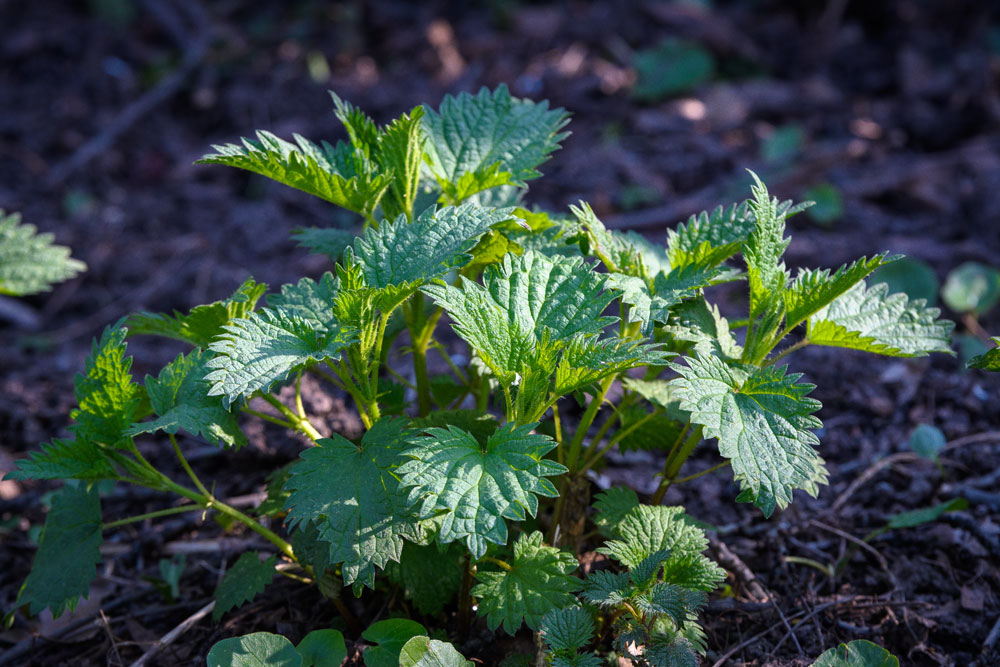Dr. Brooks Tiller
Early spring brings a newness to the woods. Turkeys are beginning to gobble and the fish are biting. But along with the thawing ground and warmer weather, we have some nutritious foods that we can forage from the forest floor.
While out chasing turkeys this early spring keep an eye out for some great edibles. While mushrooms are always popular, Dandelions and Field Garlic are a great way to begin foraging even in your backyard. A few others to look for are Asparagus, Chickweed, and Stinging Nettle.
Asparagus

Asparagus officinalis is not truly wild but a feral plant. It is the same plant you find in the produce aisle. Due to its antioxidant and anti-inflammatory properties and benefits to heart, digestion, and bones, asparagus has been used as a medicinal vegetable for centuries. Asparagus can be found in every U.S. state as well as across Canada and Mexico. Most states have asparagus zones and asparagus-free zones depending upon the soil and climate.
Soil and sun
Asparagus prefers saline or alkaline soil close to moisture. They do not like to be covered in water but close enough to reap the benefits. In the East and Southern parts of the U.S., these conditions are more common while in arid areas of the West marsh edges, ponds, streams, and irrigation ditches are prime locations to search for asparagus.
Look for asparagus to be soaking in full sunlight. Occasionally it will be near small trees or in a briar patch, but will not grow in a thick forest. To locate asparagus zones in your state, check out this map from the USDA.
What to look for
If you have ever seen asparagus at the store or a restaurant, then you know how to identify asparagus in the wild. The trick is to find it. Asparagus is an herbaceous perennial that grows above ground then dies down annually but roots survive to grow more next year. Since asparagus roots can live over 50 years, once you find a patch or even old remnants you have found a place that can be harvested year after year.
Characteristics to identify
Look for young tender spears of asparagus in the early spring as lilacs or wild mustard begins to bloom. Asparagus initially produces skinny spears, then thicker spears, and generally finishes with skinny spears before going dormant again. In perfect conditions, it can grow an inch a day, so asparagus not harvested or eaten by wildlife can grow up to 6-feet tall.
Collecting
Cut asparagus stalks with a knife a few inches above the ground. A plant can be harvested several times per year but take caution not to cut every stalk as this can weaken or even kill the plant.
Health Benefits
Asparagus is nutrient dense as it is low in calories while containing high levels of vitamins, minerals, and nutrients. Several studies have shown health benefits to include weight loss, improved digestion, lower blood pressure, reducing the effect of cell-damaging free radicals, and even improve healthy pregnancy outcomes.
Asparagus is high in folic acid, potassium, fiber, vitamin B6, vitamin A, vitamin C, and thiamine.
Preparing
The entire stalk can be cooked but to avoid the toughest most fibrous parts simply bend asparagus in your hands until it breaks. The tops are more tender and edible while the bottom thicker pieces are often tough and woody. The bottom thicker and more fibrous pieces make a great nutritious addition to vegetable stock. Asparagus will maintain freshness longer if placed in the refrigerator upright in a container with some water.
Cooking
Like most things, harvesting asparagus grown in the wild taste better, fresher, and sweeter than its cultivated counterpart. Asparagus is great roasted in the oven, added to stir fry, and grilled over an open flame.
CAUTION: Female asparagus plants produce pretty red berries that are toxic, so do not eat them!
Asparagus nutrition facts (1 cup)
- Calories - 20
- Total Fat - 0 g
- Total Carbohydrate - 5 g
- Dietary Fiber - 2.8 g
- Sugar - 2.5 g
- Protein - 2 g
- Folic acid - 60%
- Vitamin K - 38%
- Vitamin C - 20%
- Vitamin B1 - 15%
- Vitamin B6 - 10%
- Vitamin A - 8%
- Vitamin B2 - 6%
- Vitamin B3 - 5%
- Calcium - 2%
- Magnesium - 4%
- Copper - 4%
Chickweed

Chickweed (Stellaria media) is often overlooked and underrated. It is flavorful and packed full of vitamins and minerals. It has been used medicinally around the world for both humans and animals with chickens and turkey being drawn to chickweed. A tough creeping annual that begins coming up during the winter is ready to harvest in the spring.
Soil and sun
Chickweed likes fertile soil and thrives in direct sunlight. When growing in abundance, it forms dense luscious mounds. It can be found sprouting up in fields, gardens, compost piles, along sidewalks, and even our backyard.
Characteristics to identify
Chickweed is recognizable by its opposite oval pointy leaves on short soft stems. Growing on short stems separates common chickweed from other plants in the Stellaria family that are edible but not as tasty. In the late spring and summer, it will bloom with small white star-shaped flowers. While still edible, it becomes more fibrous and less palatable.
Collecting
When harvesting Chickweed pinch off the tops or snip the whole plant just above the ground. This will allow the plant to continue to grow so that we can harvest it for years to come.
Health Benefits
In traditional medicine, Chickweed has been used in the U.S. and around the world as a medicinal herb.
Digestion and weight management.
As a mild laxative and diuretic, it helps the body expel toxins and improves digestion. Studies on mice reveal that chickweed has a positive impact on body weight and food consumption.
Expectorant
Chickweed contains saponin which has been shown to break up mucus and soothe the bronchial tubes.
Wound healing and inflammation
Traditionally chickweed would be crushed into a poultice and used to relieve eye inflammation and as a salve to promote wound healing. With antiseptic and antifungal properties, it has been used to prevent cuts and wounds from becoming infected. These properties have also shown benefits to decrease inflammation and pain associated with arthritis.
Vitamins
Chickweed is a great source of vitamin C and has historically been used to treat and prevent scurvy.
Use
The tender leaves of chickweed have a fresh grassy taste. This makes them great to be tossed in raw in a salad or used as a garnish. Blend it into a pesto, add it to a stock, or nibble on some while out chasing turkeys for a great vitamin boost.
While still safe and edible, once chickweed begins to bloom it can become fibrous and stringy leaving unpleasant to eat.
CAUTION: Due to the diuretic and laxative properties, overconsumption of chickweed can lead to diarrhea. As with any diuretic, take caution if pregnant or breastfeeding. As with most herbs, use Chickweed in moderation.
Chickweed Nutrition Facts, 1 cup
- Calories - 96
- Total Fat - 1 g
- Saturated Fat - 1 g
- Polyunsaturated Fat - 0 g
- Monounsaturated Fat - 0 g
- Cholesterol - 0 mg
- Sodium - 0 mg
- Potassium - 0 mg
- Total Carbohydrate - 15 g
- Dietary Fiber - 8 g
- Sugars - 0 g
- Protein - 6 g
- Vitamin A - 4 %
- Vitamin B - 120 %
Stinging Nettle

Stinging Nettle could be ranked as the most hated or the most beloved plants we encounter. If you have ever brushed up against them, then you know why they receive their common name. But if you have ever tasted the deep herbal flavor of Urtica dioica, then you know why it is one of the most popular wild edibles used by restaurants.
Originally from Europe, Stinging Nettle is one of the most nutritious wild food plants that has been naturalized and considered invasive across the United States.
Soil and Sun
Nettles like a moist nitrogen dense soil where they can get direct sunlight. Often found in rich soil along streams, in pastures on old farms, open woods, and even thickets.
Identification
A hardy herbaceous perennial with ribbed hollow stems that can grow up to 7 feet tall with opposite leaves. The dark green oval leaves are rough, pointed, with course teeth. The stem and leaves are covered in tiny hairs that appropriately give the name stinging as they produce an intense stinging pain with just the slightest brush of contact.
Collecting
Always wear gloves and long sleeves when collecting and handling Stinging Nettle to prevent the stinging hairs from touching bare skin. The stems and leaves can be harvested until it begins to flower. To ensure the plant continues to grow, cut the plant above the branching out of a leaf.
Health Benefits
Stinging Nettle is one of the most nutrient dense plants we can eat. Studies show that it can aid in UTI infections, increase circulation, reduce the risk of prostate cancer, alleviate allergic reaction, and decrease inflammation. It contains nutrients that help to improve bone health, combat hair loss while promoting hair health and growth, as well as remove toxins from the body.
Nutrient and Vitamin rich
- Calcium
- Phosphorus
- Beta-carotene
- Iron
- Magnesium
- Vitamins A, B, C, D
- Protein
Formic acid
The formic acid that gives Stinging Nettle its sting has medicinal and antibacterial properties at low doses.
Use
Stinging Nettle must be handled with care until cooked. Cooking neutralizes the stinging effect. Once cooked the stems and leaves can be eaten.
It is great steamed and then used in a quiche similar to spinach. It can also be used in soup, pesto, omelets, or as a side dish. The leaves can also be dried for flavorful and nourishing herbal tea.
CAUTION: Wear gloves and long sleeves when harvesting and preparing. The hairs can cause a stinging or rash that can last days. Do not eat raw! Stinging irritated skin is bad enough, but you do not want to feel like you have swallowed a jellyfish! Clearweed (Pilea pumila) looks similar to stinging nettle but does not have stinging hairs and while not-toxic is unpalatable.
Nutrition facts of Stinging Nettle (1 cup)
- Calories - 42
- Total carbohydrates - 7 g
- Dietary fiber - 7 g
- Sugar - 0.3 g
- Protein 2.7 g
- Sodium - 4 mg
- Potassium - 334 mg
- Vitamin A - 40%
- Calcium - 48%
- Iron - 8%
- Magnesium - 14%
- Vitamin B6 - 5%

Need wild game meat for a recipe you've been wanting to try? Check out GameKeeper Butchery. GameKeeper Butchery is dedicated to procuring the finest assortment and highest quality of specialty meats from the United States and around the world. Our commitment is to deliver the safest, freshest and most wholesome products.




























